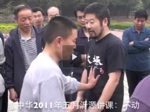When I first started taiji training with my teacher Kee Hong, he would always say: if you want power, you have to sink your weight. In fact, I would observe his center of gravity sink whenever someone pushed him. I would also feel his push getting “under me” whenever I pushed on him.
The only thing I could understand from this was that I had to bend my knees more to lower my center of gravity. I thought it was a sure bet that I would be able to issue some sort of power. This shouldn’t be too hard, I told myself, with more than a decade of dedicated Shaolin training with heavy emphasis on stances — I should definitely have the leg strength to be able to bend my knees more. But I was absolutely unable to do any of what my teacher and his teacher was doing. In fact, it felt like when I would lower my center of gravity, it would make my training partner more stable. After a while, things started to make sense: when I would try to lower my center, I was bending the ankle of my rear foot rather than the knee. This had many negative effects:
- Put stress on my ankle.
- Put stress on my knee, that would easily lead to bad alignment (on this, see Knee Problems? The Importance of Knee Alignment).
- Lead to “tossing” in the knee .
- Tend to make my spine bend forward, compromising the central axis of the body.
I started observing my teacher, his classmates and his teacher more closely. I noticed that the most advanced practitioners would not bend their ankles significantly, but would rather only bend the knee without bending the ankle. I started experimenting with this, and noticed some remarkable difference. I shifted my focus away from the joint, and more on bringing the thigh at a 90 degree angle to the lower leg. Many drills that Kee Hong and Chen Zhonghua had taught me started producing results. Through this, I think I managed to start activating the hinge-like action, at least in the rear hip. I could finally stay “between my feet” when I was lowering my center of gravity.


